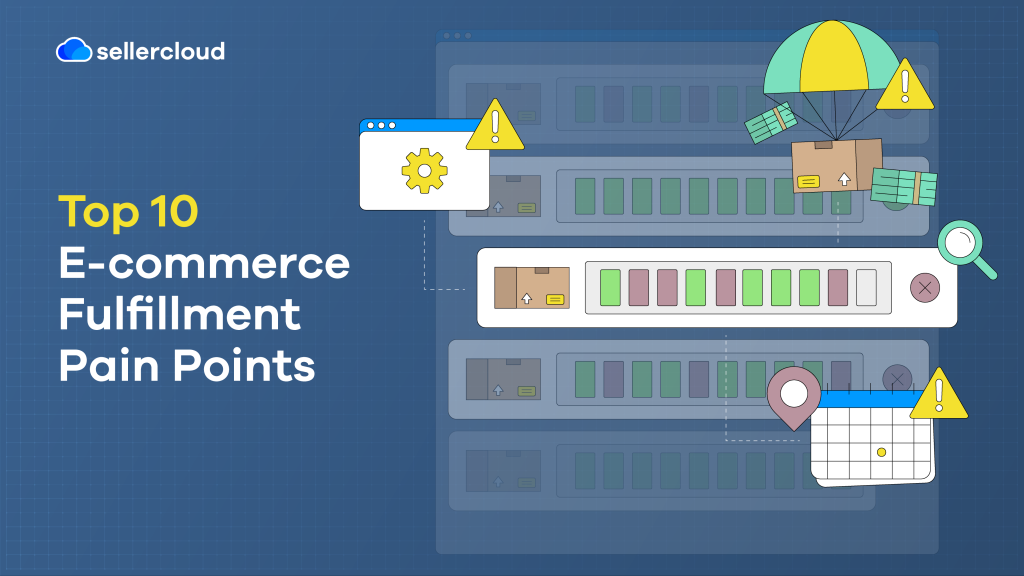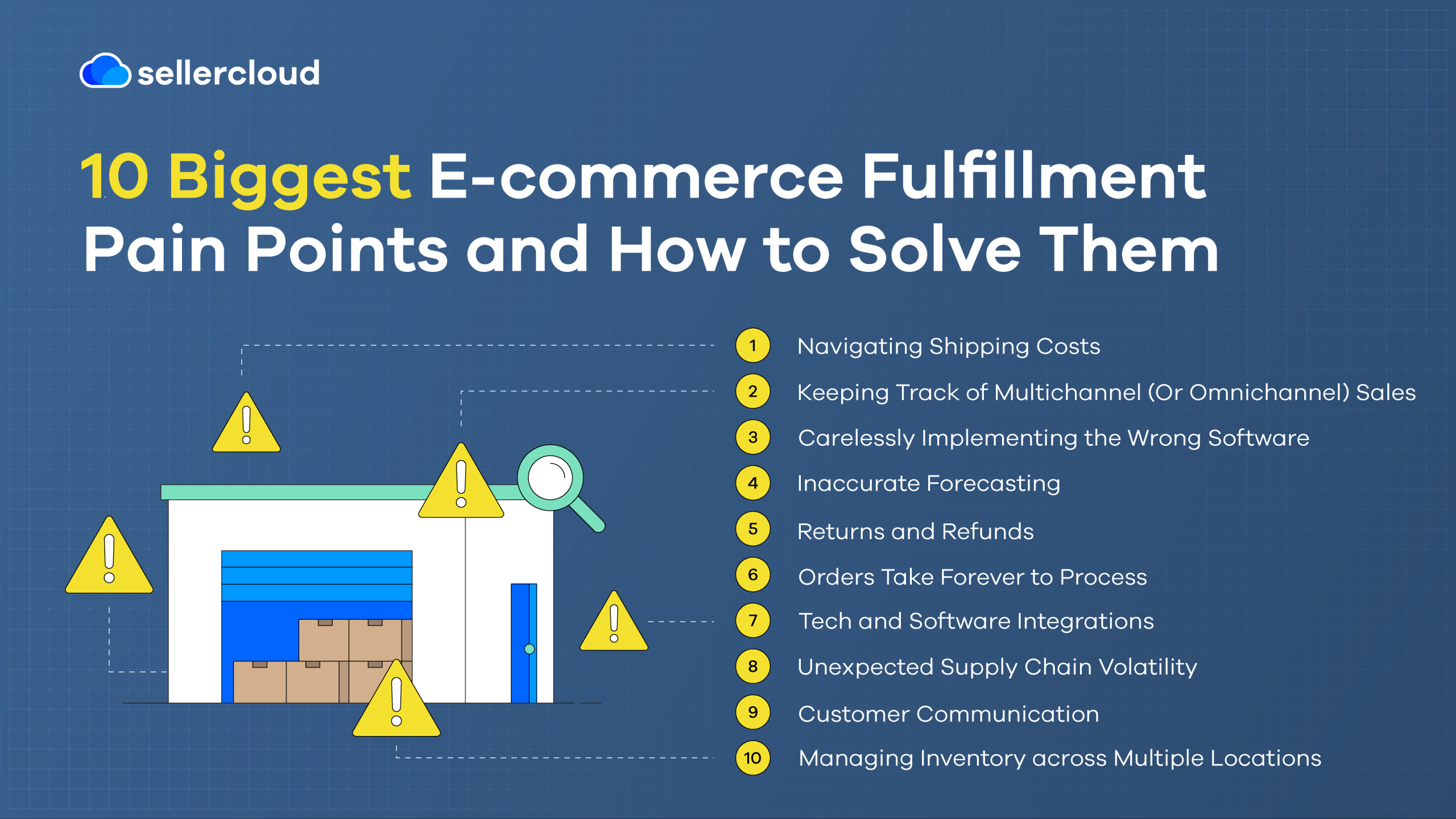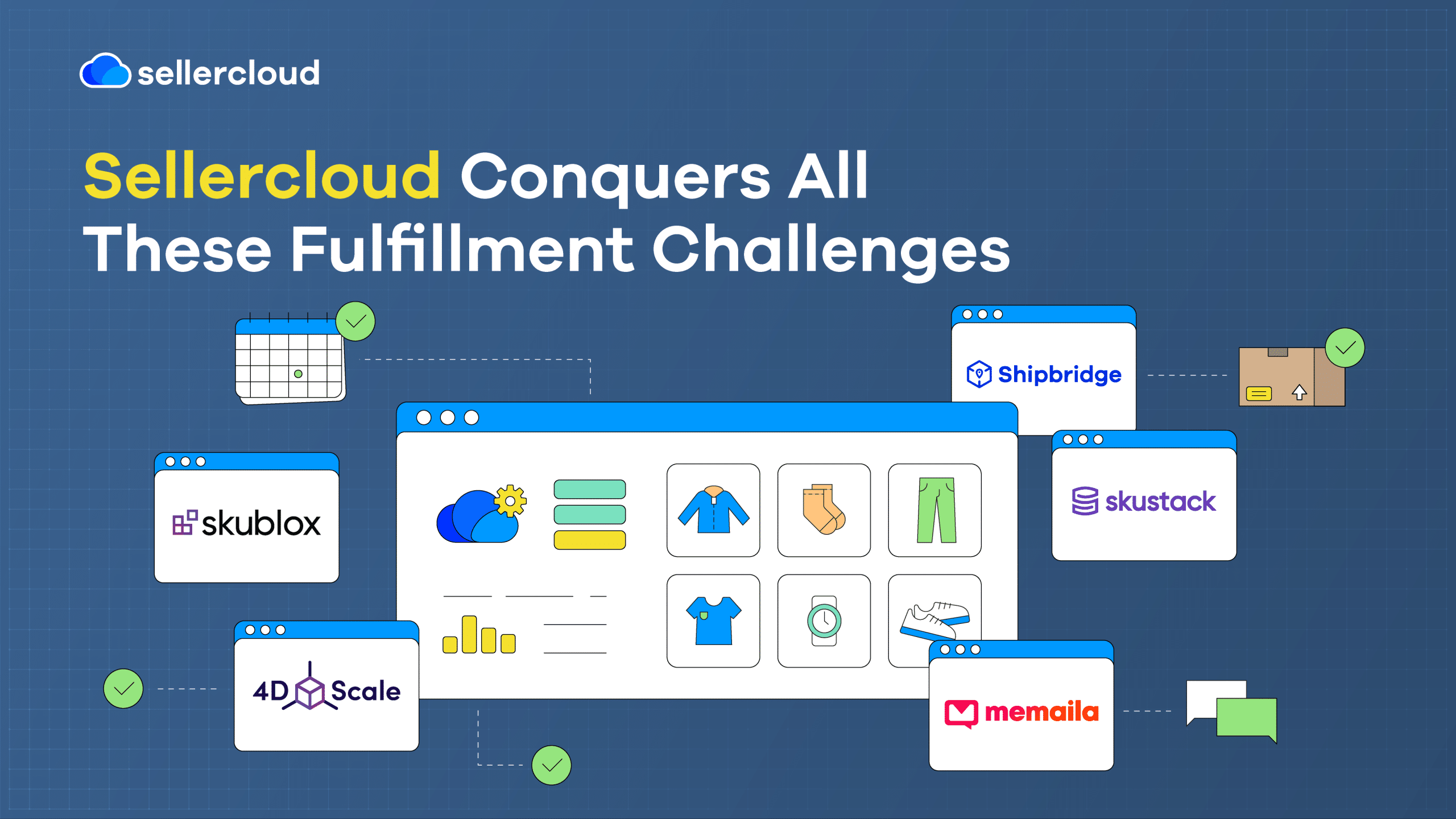
- As your ecommerce business grows, you will only encounter more fulfillment challenges. While some may be harder than others, there are always effective workaround solutions.
- Descartes Sellercloud offers a range of features and integrations to help ecommerce businesses overcome these challenges.
No one ever said fulfilling orders online would be easy. Sure, it seems straightforward enough—the customer purchases the product, you ship the product, and the job is done!—but we all know it can get very complicated quickly.
The ecommerce industry has grown at an astounding rate. Jason Goldberg of Forbes writes that US ecommerce sales have grown 87% year-on-year since 2019. Adding that, “Total US ecommerce sales for the entire period of the pandemic (from Q2 2020 through Q3 2022) are more than $630B higher than pre-pandemic forecasts.”
So, what does this mean for the average ecommerce seller? This means ecommerce companies are growing faster than ever, and as they grow, they will encounter many common ecommerce fulfillment pain points.
This article will reveal the biggest pain points in ecommerce fulfillment and explain how sellers can overcome them.
10 Biggest Ecommerce Fulfillment Pain Points and How to Solve Them

Let’s examine the biggest challenges ecommerce companies face when fulfilling orders and the best solutions. Here are the top 10.
1. Navigating Shipping Costs
The problem: Shipping costs will always be an expense that needs to be handled. It’s just the cost of doing business. However, in an ideal world, it’s an expense you’ll want to reduce. The less control and choice you have over shipping costs, the more expensive they can be. You could be missing out on real cost-saving opportunities.
According to an article by Kim Souza of Talk Business & Politics, FedEx and UPS could raise their rates between 8% and 10% in 2023. That doesn’t mean you should stop using either, but it does mean that merchants should be more open to alternatives and compare different shipping rates to ensure they’re getting the best rate possible.
The solution: You need a tool like Shipbridge to handle shipping tasks. Shipbridge can help you find the best rates with the best couriers. It can also automate shipping workflows and works with customizable plugins. Sellers can also utilize the 4D Scale, which helps them accurately measure a package’s weight and dimensions.
In addition, Descartes Sellercloud is also integrated with the top couriers in the US, so you can always find the most convenient shipping service.
2. Keeping Track of Multichannel (Or Omnichannel) Sales
The problem: To thrive in ecommerce today, you must sell on multiple marketplaces. You shouldn’t just stick to Amazon and eBay because you’ll miss many shoppers who prefer different platforms. However, this creates a problem—you can’t see all your sales in one place. You need to log into one platform and then the next.
While this is not exactly practical, the real problem is that it can cause human error because it does not allow you to see the full picture. Because your inventory data from different platforms is not synchronized, this has a knock-on effect on order fulfillment, increasing the likelihood of stockout or selling stock you don’t have.
The solution: Descartes Sellercloud acts as a centralized point where your entire inventory can be accounted for across all the marketplaces you sell on. You can also change your listings from one place instead of manually making the changes on each platform.
On a more complex level, within Descartes Sellercloud, you can set up different companies for your business to sell products in different countries or target different audiences. Other helpful features include allocating, reserving, and tracking inventory, creating kits and product variations, and vital reporting features.
3. Carelessly Implementing the Wrong Software
The problem: If your inventory is not handled properly, it can make it extremely difficult to fulfill your orders effectively—and more importantly, it can be extremely costly.
A legendary example of this was in 2001 when Nike implemented inventory management software to manage its supply chain without properly understanding how it might impact its business. As Christopher Koch of CIO summarized in 2004, “It was too slow, didn’t integrate well, had some bugs, and Nike’s planners were inadequately trained in how to use the system before it went live.” The ill-advised integration ultimately cost Nike $100 million in sales.
The solution: The solution here is to thoroughly research the available software options and the tools they offer merchants to manage their inventory and fulfill orders. For example, Descartes Sellercloud’s Skustack helps warehouse pickers locate products throughout the warehouse, scan them, pick them, and move them on for shipment.
Descartes Sellercloud also offers Skublox, which simplifies boxing and preparing orders for shipment with its put-to-light and pick-to-light technology. Picked items are placed into the picking bin and organized into slots based on their destination. On the other side of the wall, when a slot is complete with orders, they are collected and packed for shipping.
You can also check out our inventory management guide to learn more about effective inventory management.
4. Inaccurate Forecasting
The problem: You can’t predict the future. Unfortunately, no one can. Forecasting demand helps reduce the possibility of businesses running out of inventory or ordering in excess. If you don’t track inventory and collect data, it’s impossible to forecast and prepare for changes in demand—you can be caught off guard by increasing or decreasing demand, and both can be costly.
The problem this creates is that you cannot fulfill orders because you don’t have the right amount of stock.
The solution: Use software that collects this information and produces reports to help you forecast and plan better for the coming weeks and months. Again, Descartes Sellercloud can help with this. Descartes Sellercloud can help collect data about your orders and use it to create forecasts based on demand and past sales.
Even better, you can automate these orders by setting up customizable rules for your business. Furthermore, Descartes Sellercloud’s reporting features can also be used for decision-making.
5. Returns and Refunds
The problem: Returns and refunds are never fun, but they’re a fact of life and will happen no matter how efficient your business is. According to research by Capital One Shopping, “The average retail return rate is 16.4% for eCommerce and 16.5% for in-store purchases.” That’s a sizable chunk of sales that needs to be dealt with as swiftly and easily as possible.
Returns and refunds are tricky to organize because products can be sent back to merchants for various reasons.
The solution: Make returns and refunds easier to deal with to avoid upset customers and keep your fulfillment operations running smoothly. Descartes Sellercloud and its products make each part of the returns process easier and faster. Firstly, in Descartes Sellercloud, you can easily generate and print RMAs, which helps sellers (and customers) keep track of returns.
Skustack can also be used to perform an SKU-to-SKU transfer, where a used product can be rebranded by swapping the SKU to classify it as used or refurbished.
6. Orders Take Forever to Process
The problem: The longer an order takes to process, the more precious time you could miss where it could be in transit to the customer. Your order processing could be disorganized and needs to be rethought. In an ideal world, the fulfillment process should be as streamlined as possible.
You should ask yourself, “What is our average order cycle time?”—the time it takes for an order to be processed and fulfilled from when it is placed until the customer receives the product. Bear in mind that every business, warehouse, and the types of products they deliver are different, impacting your order cycle time (don’t compare it to other businesses!).
According to Shippo’s State of Shipping Report 2023, 44% of customers typically purchase shipping for two to three days. Merchants need to ensure they can at least meet these expectations without sacrificing the quality of their orders.
The solution: You can speed up order processing by combining tools like Skustack, Skublox, and Shipbridge. With Skustack, as explained earlier, picking is made easier. Diving deeper, Skustack also offers what is called ‘regional picking,’ where orders are only picked from specific warehouse regions.
This enables pickers to divide their workload by region and increase efficiency. Additionally, as explained above, Skublox helps with sorting packages. You can also use Shipbridge to view all orders in one place instead of multiple partner platforms and use Descartes Sellercloud’s Order Rule Engine to set conditions for certain actions.
7. Tech and Software Integrations
The problem: You may use several services to optimize your order fulfillment, but access them from different places. Because of this, information might not always be in sync, or services your business needs might not be available or integrate well with what you already have.
An article by McKinsey says, “A robust tech foundation can give retailers the capabilities to boost performance across the board, but to date, most organizations haven’t made sufficient progress.” McKinsey believes technology will be a “core driver of next-generation retail growth.” So, it’s of utmost importance to get your tech and software in order.
The solution: Descartes Sellercloud has over 350 integrations at the time of writing. It can be a centralized platform to access your most used fulfillment services. More impressively, Descartes Sellercloud can create custom plugins (it’s our specialty) to help clients work the way they work best.
There aren’t many ecommerce services you can’t access, and Descartes Sellercloud’s list of integrations will only keep growing.
8. Unexpected Supply Chain Volatility
The problem: Sometimes vendors run into problems and cannot get inventory to you, which can have a catastrophic impact on your business’s ability to meet orders. According to an article by Willy C. Shih of the Harvard Business Review, the US-China trade war and the COVID pandemic have forced many manufacturers to rethink their supply chains.
However, what if there is another global pandemic or a worldwide recession? How will it impact your partners and suppliers’ ability to work with you and complete orders? Supply chain volatility can jolt your business and almost appear to come from out of nowhere. Ecommerce businesses must be flexible and responsive to avoid unexpected supply chain volatility. However, that’s easier said than done.
The solution: Merchants need intelligent software to help them make reactive decisions and keep fulfilling orders, even when their suppliers are failing. Descartes Sellercloud gives merchants this much-needed flexibility. In Descartes Sellercloud, when you create a PO (Purchase Order), and the supplier cannot fulfill it, you can update the estimated delivery date or change the supplier directly to a new supplier with just a few clicks and avoid chaos.
Even better, Descartes Sellercloud also supports vendor inventory feeds, so sellers can see how much inventory a vendor has. This way, sellers won’t be caught off guard when their supplier suddenly runs out of products. You won’t be able to make the problem disappear, but you can do your best to minimize the fallout from the volatility.
9. Customer Communication
The problem: Communicating with customers on several different platforms is very challenging. Messages can get lost, and customers can become irate. A report by PwC states that “Nearly 80% of American consumers say that speed, convenience, knowledgeable help and friendly service are the most important elements of a positive customer experience.”
Speed and convenience are hard to provide when you’re lost in a mountain of messages on multiple marketplaces. You may miss important messages regarding deliveries and anger customers.
The solution: You need a tool that can centralize all your customer communication to one place, like Memaila, so you never miss out on customer queries. (Note that for now, Memaila only works to communicate with customers on Walmart, Amazon, and eBay.)
10. Managing Inventory across Multiple Locations
The problem: The more locations your inventory is spread across, the more you’ll grind your teeth with frustration when the inventory you need is not in the right place. You may have multiple warehouses because you need more space or have warehouses strategically placed to fulfill orders in different parts of the country, for example.
Inventory in one or more locations needs to be moved around to free up space, and records need to be updated properly to show the change or risk havoc when pickers can’t find them on the warehouse floor.
The solution: In Shipbridge, you can set up ‘locations’ and ‘stations,’ which are areas where orders are handled. Setting up locations and stations in warehouses enables merchants to have greater control and oversight of their fulfillment operations. Merchants can then filter orders by location and station to avoid confusion.
Furthermore, you can restrict a channel to only see inventory for one warehouse—for example, Etsy orders are only fulfilled by one warehouse.
Descartes Sellercloud Conquers All These Fulfillment Challenges

Descartes Sellercloud, its range of products, and an army of integrations can help merchants squash all these fulfillment challenges and more. In this article, we have mentioned:
- Descartes Sellercloud—Centralizes your entire ecommerce operations, makes handling inventory much easier, and has listings across multiple marketplaces. It offers customizable plugins and a whole lot more.
- Shipbridge—Enables sellers to manage their shipments from one interface and empowers sellers to be flexible when needed.
- 4D Scale—Accurately weigh and measure the dimensions of packages before shipping them out to get the exact rate that works for you.
- Skustack—Empowers sellers to better organize their warehouse and pick products, as well as track warehouse activity.
- Skublox—Trim the time it takes to pick, sort, and prepare products for shipment with Skublox’s put-to-light and pick-to-light technology.
- Memaila—Communicate with Amazon, eBay, and Walmart customers from one place.
- Descartes Sellercloud’s integrations—With over 350, you can integrate whatever service you need.
Book a Descartes Sellercloud demo today.
Key Points
Fulfillment challenges don’t have to get you down. Remember these key points.
- As ecommerce companies grow, they will face more challenges, but these fulfillment pain points can be overcome with proper planning and the right tools.
- Carelessly implementing a software solution you don’t understand can be a massive mistake—ensure you only adopt industry-leading technologies like those offered by Descartes Sellercloud.
- Likewise, ensure that the software solution you adopt is compatible with the services you already use.
- Merchants must be prepared for the unexpected. Supply chain volatility can seemingly come out of nowhere, and merchants must be able to react to mitigate the impact on orders.
- With Descartes Sellercloud and its range of products, features, and integrations, merchants can minimize common ecommerce fulfillment pain points.




